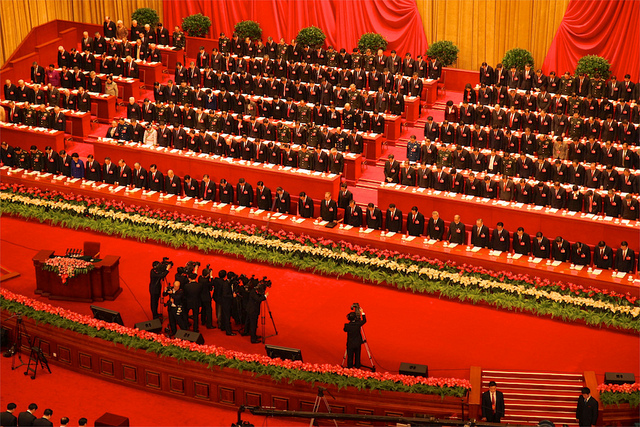
China has made concerted efforts to reduce corruption at the lowest levels of government. Image of the 18th National Congress of the CPC in the Great Hall of the People, Beijing, by: Bert van Dijk.
Ed: Investment by the Chinese government in internal monitoring systems has been substantial: what components make it up? Jesper: Two different information systems are currently in use. Within the government there is one system directed towards administrative case-processing. In addition to this, the Communist Party has its own monitoring system, which is less sophisticated in terms of real-time surveillance, but which has a deeper structure, as it collects and cross-references personal information about party-members working in the administration. These two systems parallel the existing institutional arrangements found in the dual structure consisting of the Discipline Inspection Commissions and the Bureaus of Supervision on different levels of government. As such, the e-monitoring system has particular ‘Chinese characteristics’, reflecting the bureaucracy’s Leninist heritage where Party-affairs and government-affairs are handled separately, applying different sets of rules. On the government’s e-monitoring platform the Bureau of Supervision (the closest we get to an Ombudsman function in the Chinese public administration) can collect data from several other data systems, such as the e-government systems of the individual bureaus involved in case processing; feeds from surveillance cameras in different government organisations; and even geographical data from satellites. The e-monitoring platform does not, however, afford scanning of information outside the government systems. For instance, social media are not part of the administration surveillance infrastructure. Ed: How centralised is it as a system? Is local or province-level monitoring of public officials linked up to the central government? Jesper: The architecture of the e-monitoring systems integrates the information flows to the provincial level, but not to the central level. One reason for this may be found by following the money. Funding for these systems mainly comes from local sources, and the construction was initially based on municipal-level systems supported by the provincial level. Hence, at the early stages the path towards individual local-level systems was the natural choice. A reason for why the build up was not initially envisioned to…
